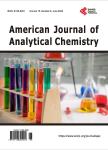Copper and Mercury in Food, Biological and Pharmaceutical Samples: Spectrophotometric Estimation as Cu(DDTC)<sub>2</sub>
Copper and Mercury in Food, Biological and Pharmaceutical Samples: Spectrophotometric Estimation as Cu(DDTC)<sub>2</sub>作者机构:Department of Chemistry University of Chittagong Chittagong Bangladesh
出 版 物:《American Journal of Analytical Chemistry》 (美国分析化学(英文))
年 卷 期:2014年第5卷第13期
页 面:838-850页
主 题:Copper Mercury Diethyldithiocarbamate Spectrophotometric Method Food Biological Pharmaceutical Samples
摘 要:An alternative spectrophotometric method was optimized and validated for the estimation of mercury using diethyldithiocarbamate (DDTC), a common reagent, widely used for the preconcentration and isolation of metal ions in complex matrices followed by their estimation by varied techniques. Diethyldithiocarbamate forms yellow Cu(DDTC)2 with copper and white Hg(DDTC)2 with mercury (having d10 system) which are extracted in CCl4. The UV-visible spectrum of Cu(DDTC)2 is very stable at pH 5.0 and has a maximum absorption (λmax) at 435 nm. Hg(DDTC)2 is more stable than Cu(DDTC)2. Estimation of mercury is based on a quantitative displacement of Cu(II) of Cu(DDTC)2 with the addition of mercury followed by the measurement of reduced absorbance. Primarily, method was optimized and validated for the estimation of copper. Therefore, simultaneous determination of Cu(II) and Hg(II) in mixture is proposed fractionating the extract. The molar specific coefficient (ε) for the mercury was 1.4 × 104 mol﹣1·L·cm﹣1 and for copper was 3.16 × 105 mol﹣1·L·cm﹣1 at 435 nm. The detection limits of Cu2+ and Hg2+ were 0.023 μg·mL﹣1 and 0.029 μg·mL﹣1, respectively. The calibration curve shows good linearity of 0.02 - 12.0 and 0.02 - 15.0 μg·mL﹣1 for the Cu2+ and Hg2+ determination, respectively. Proposed technique was applied to food, biological and pharmaceutical samples for the determination of Cu(II) and Hg(II).



